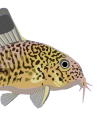Lloydy wrote:Has anyone ever seen their Plecs shaking/vibrating, usually just before a fight? I assume this is a warning they give off to other Plecs as i've never seen them do this around other fish.
I have 4 x L14 that are all about 5-6" and as they are getting bigger and I suppose more territorial, I have noticed more fights and more vibrating, especially between the largest two.
Has anyone else seen this before and do all Plecs do it or just certain species because I never saw my L333s do this?
One day I might even catch this strange behaviour on career!

Ethologists(those who study animal behavior) have given this fish behavior a name. It is called agonistic behavior.
You see this behavior in nearly all fish during courtship and spawning behaviors.
It is usually used by rival males first to establish dominance and to avoid a full blown fight. But if they fight they display much more intense agonistic behavior.
One well known example is the fighting behavior of Betta splendens. This has been increased through selective breeding by those who breed fighting Bettas. Betta splendens fights sometimes do result in the death of the loser. The winning fish are saved for breeding future fighting stock. These are the Plakat B. splendens.
In Northern Thailand, they mostly use Betta smaragdina. The rules are different and fights to the death are rare. Losers are decided by which fish first goes from confrontational to submissive behavior.
Discus have highly ritualized agonistic behavior when they are establishing the general hierarchy and again between a male and female testing each other as potential mates. It is also a critical aspect in the way brooding Discus communicate intent and control over their fry.
It has been studied a great deal in animal behavior laboratories where a popular species of Dwarf Cichlid, Nannacara anomala is a favorite lab animal.
I have seen agonistic behavior between many plecos that are contesting ownership of a cave or to establish their dominance in the breeding male hierarchy. I actually take steps to enhance these behaviors by limiting the numbers of cave that are available. It can help begin breeding behavior. Sometimes females vying for a male pleco's attention will also indulge in agonistic behavior. It is again to establish the hierarchy between two or more females.
I have seen L333 present agonistic behaviors many times. All fish have some form of agonistic behaviors and these behaviors present themselves in a wide range of ways. Even the small Tetras show agonistic behavior. Really fun examples among small Characins is seen among the Pencifishes.
Avid Trout fly fisherman. ·´¯`·...¸><)))º>




